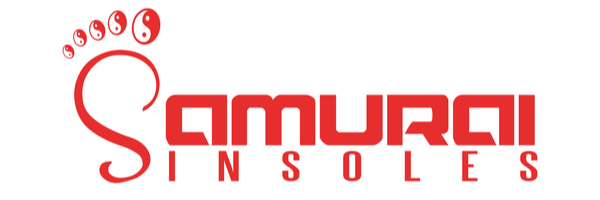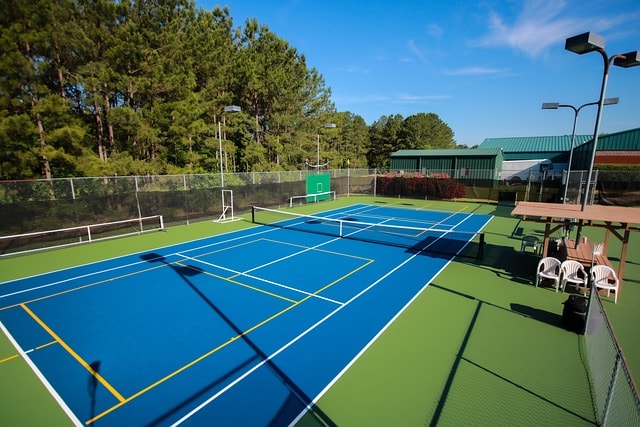When you have overpronation, the right insoles aren't just about cushioning. They're about providing critical arch support and heel stability to get your foot's alignment back on track. Think of them less as a soft pillow and more as a biomechanical tool, skillfully designed to guide your foot into a more neutral position. This correction is what eases the strain that can cause pain in your feet, ankles, knees, and even your back.
What Is Overpronation and How It Affects You
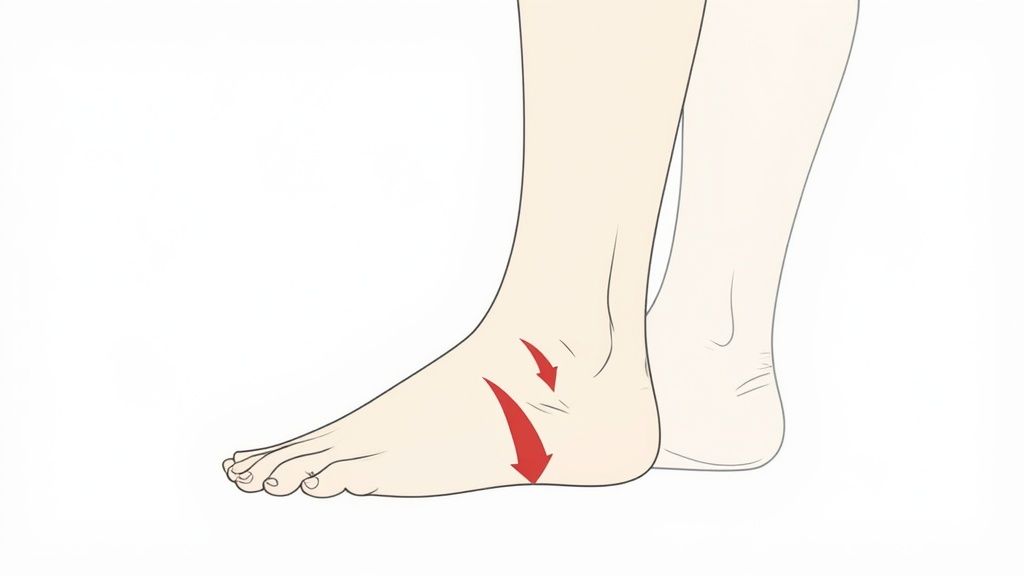
Picture your feet as the foundation of your house. If that foundation is crooked or unstable, everything built on top of it—your ankles, knees, hips, and spine—gets thrown off balance. That's a perfect way to understand what's happening with overpronation.
At its core, overpronation is just the excessive inward roll of your foot when you walk or run. A little bit of inward motion (called pronation) is totally normal; it's how our bodies absorb shock. The trouble starts when it becomes "over" pronation. This exaggerated movement causes your arch to collapse and your ankle to twist inward, setting off a chain reaction.
The Ripple Effect of Pain
It’s a lot like driving a car with poorly aligned wheels. It doesn't just wear out one tire faster. The constant vibration and stress can mess with the axle, the suspension, and even the steering. Overpronation works the same way, sending stress rippling up through your body.
When your foot rolls in too far, it forces your lower leg to rotate inward as well. This subtle, repetitive twisting can lead to a whole host of problems:
- Ankle Pain: The joint is constantly strained as it fights to keep your foot stable.
- Shin Splints: Muscles in your lower leg get overworked trying to control your foot's unstable motion.
- Knee Pain: The misalignment travels right up to the knee, often causing the kneecap to track improperly.
- Hip and Lower Back Pain: Your body tries to compensate for the shaky foundation, leading to muscle imbalances and aches all the way up into your hips and spine.
Overpronation isn't just a "foot problem"—it's a full-body alignment issue. The stress it puts on your joints can be the hidden culprit behind chronic aches that, at first glance, seem to have nothing to do with your feet.
How to Spot the Signs of Overpronation
You don't need a fancy degree to spot the classic signs of overpronation. In fact, the proof is often right there on the shoes you wear every day.
Take a look at a well-worn pair of your shoes and flip them over. Do you see a lot of wear on the inside edge of the sole, especially near the ball of your foot and your big toe? That's a textbook sign. This wear pattern shows exactly where your foot is pushing off as it rolls too far inward.
Another easy way to check is the "wet test." Get the bottoms of your feet wet, then step onto a piece of cardboard or a dry patch of pavement. A foot with a healthy arch will leave a print with a noticeable curve on the inside. But if your footprint is a solid, flat blob, that's a big clue you have fallen arches, which almost always go hand-in-hand with overpronation.
This kind of mechanical issue is incredibly common. It’s a major reason why the global market for foot orthotic insoles, including those for overpronation, was valued at USD 4.22 billion in 2024 and is expected to hit USD 7.16 billion by 2032. It shows just how many people are realizing that healthy feet are key to overall well-being.
To help you identify the issue, here's a quick reference table of common signs.
Common Signs of Overpronation
Use this quick reference table to check for common symptoms associated with overpronation.
| Symptom or Sign | What You Might Notice |
|---|---|
| Uneven Shoe Wear | The inner soles of your shoes are significantly more worn down than the outer soles. |
| Flat Feet or Fallen Arches | Your entire foot touches the ground when you stand, with little to no visible arch. |
| Foot & Ankle Pain | Aching or tenderness along the arch of your foot, the heel (plantar fasciitis), or on the inside of your ankle. |
| Shin Splints | Pain along the front or inside of your shin bone, which worsens with activity. |
| Knee, Hip, or Back Pain | A dull, persistent ache in your knees, hips, or lower back that doesn't have another obvious cause. |
| Bunions or Hammer Toes | These deformities can develop or worsen over time due to the improper alignment and pressure caused by overpronation. |
Recognizing these signs is the first step toward finding relief.
While these home checks are great starting points, you can also learn more about targeted exercises and treatments. To dig deeper, take a look at our complete guide on how to fix overpronation and start restoring your body's natural alignment.
How Insoles Correct Your Foot's Alignment
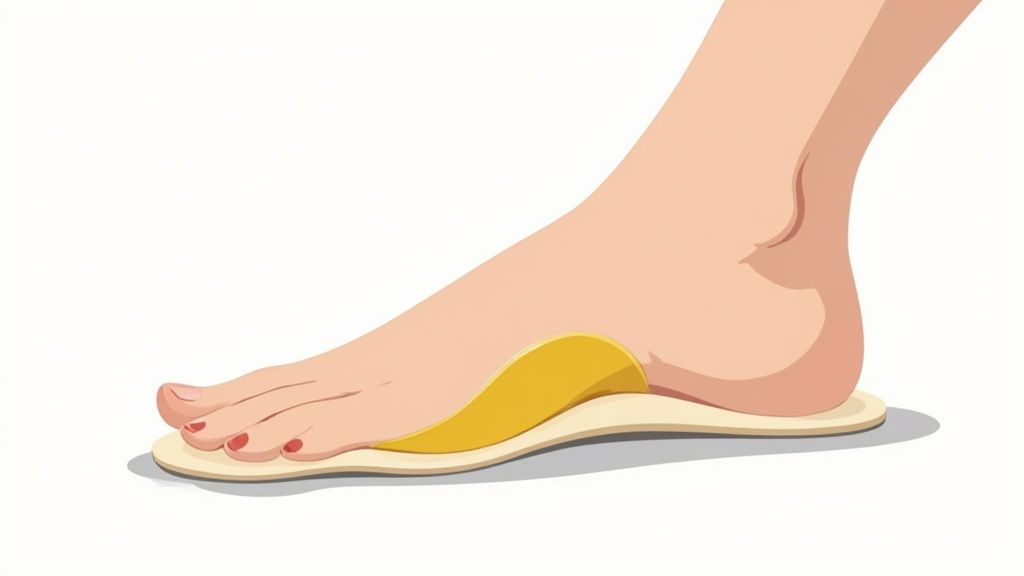
It’s a common mistake to think of insoles as just soft, cushy pads for your shoes. While extra padding can feel nice for a moment, it does almost nothing to fix the actual problem of overpronation. It’s a bit like propping a pillow against a leaning wall—you aren't fixing the foundation, so the wall is going to keep on leaning.
Truly effective insoles for overpronation are much more sophisticated than simple inserts. Think of them as biomechanical tools, engineered to act like a structural brace for that leaning wall. Instead of just softening the blow of each step, they actively guide your foot back into its proper, neutral position.
This realignment is what brings real, lasting relief. It's all about correcting the cause of the strain, not just putting a temporary band-aid on the pain. By giving your feet the stability they’re missing, the right insoles can restore their natural function and stop that damaging chain reaction of pain before it even gets started.
The Science of Support and Stability
So, how can a simple-looking piece of material actually realign your entire foot? The magic lies in two key features working together: a structured arch support and a deep heel cup.
Picture your foot's arch as a small bridge. With overpronation, that bridge collapses a little more with every single step you take. A quality insole provides the scaffolding needed to hold that bridge up, preventing it from flattening out under pressure.
This isn’t about forcing your arch into some weird, unnaturally high shape. It’s about giving it firm but flexible support so it can hold its intended structure. This one action has a huge ripple effect, stopping the excessive inward roll of your foot and ankle right in its tracks.
Your Heel Is the Steering Wheel
While the arch gets all the glory, the heel cup is equally critical. In fact, you can think of your heel bone as the steering wheel for your foot. If it isn't held securely, your foot is free to wobble and roll inward however it wants.
A deep, stabilizing heel cup solves this by cradling your heel’s natural fat pad. This accomplishes two very important things:
- It locks your heel in place, preventing the side-to-side sloppiness that kicks off the overpronation motion.
- It aligns the subtalar joint, which sits just below your ankle and controls most of your foot’s side-to-side movement. Keeping it stable is essential for proper alignment.
By controlling the heel, the insole essentially steers your entire foot onto a more neutral, efficient, and pain-free path with every step.
The goal of a corrective insole is not to cushion, but to control. By managing the motion of the heel and supporting the arch, it redirects forces away from stressed joints and muscles, providing stability from the ground up.
This one-two punch of arch and heel control fundamentally changes how your foot hits the ground. Instead of collapsing inward, it’s guided through a much healthier range of motion.
The benefits are huge and travel far beyond your feet. When you fix your body’s foundation, the positive effects can be felt all the way up the chain. The right insoles can:
- Reduce strain on the plantar fascia, a leading cause of stubborn heel pain.
- Prevent the excessive inward twisting of the shin and knee, which can help with shin splints and knee pain.
- Improve your overall body posture by creating a stable base, potentially easing aches in your hips and lower back.
Insoles for overpronation don't just add temporary comfort. They provide a real, functional correction that brings your body back into balance, offering relief and preventing future injuries with every step you take.
How To Choose The Right Insoles For Overpronation
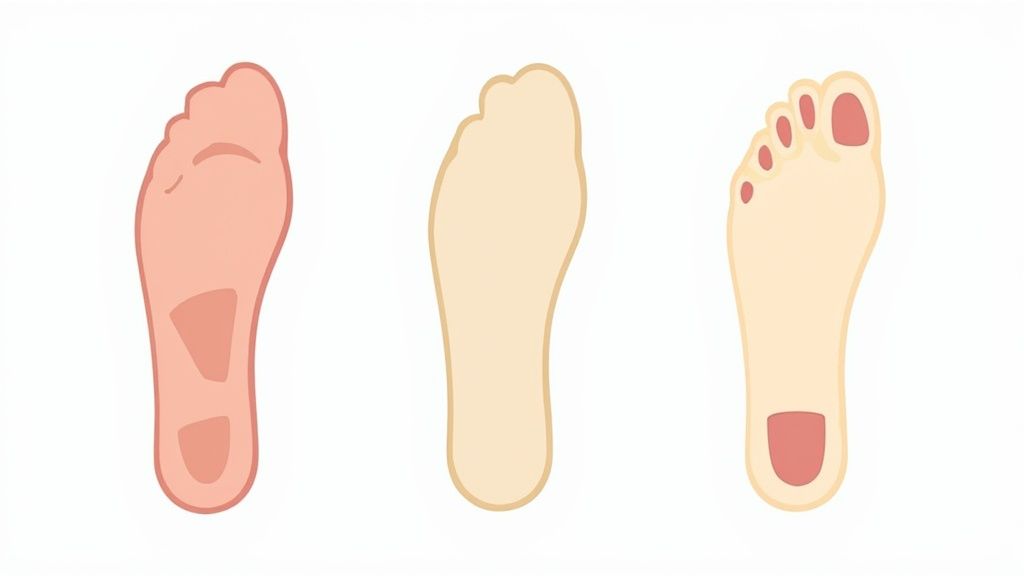
Walking into a store or browsing online for insoles can feel completely overwhelming. You're hit with a wall of options, from squishy gel inserts to rock-hard plastic plates, and it’s tough to know what will actually help your overpronation. Getting this choice right is crucial, because the wrong insole isn't just ineffective—it can make things worse.
The first thing to get straight is the difference between cushioning and correction. Most of the insoles you see in big-box stores are just soft padding. They might feel nice for a minute, but they’re like putting a fluffy rug on a slanted floor; they do nothing to fix the underlying tilt.
True insoles for overpronation are built for structural support, not just softness. Their job is to guide your foot into a healthier alignment, giving you a stable foundation with every step you take.
Material and Rigidity: The Core of Support
The material an insole is made from directly determines how well it can control your foot's motion. The right choice really comes down to what you need more: support or flexibility.
Think of it like choosing materials to build a house. Soft, flimsy materials like gel and memory foam offer fantastic cushioning but give you almost zero structural support to correct overpronation. They squish down easily under your body weight, letting your arch collapse just like it would without them. These are really for people who just want an extra layer of softness, not for those of us who need to fix our alignment.
On the other hand, firm, structured materials are where you find real control.
- Firm Foam: Materials like high-density EVA foam strike a great balance between support and comfort. They’re firm enough to prop up your arch but have just enough give to absorb shock and feel good underfoot.
- Cork: As a natural material, cork molds to your foot over time while still providing excellent, rigid support. It's a solid choice for anyone needing a very stable base.
- Composite or Carbon Fiber: You’ll find these in very rigid, often custom, orthotics. They offer maximum control and are super lightweight, but they can feel too hard for many people, especially if you're new to supportive insoles.
The right insole for overpronation should feel supportive, not just soft. It needs to be firm enough to resist the force of your collapsing arch, creating a stable platform for your foot.
Matching Insoles To Your Life
Your daily routine plays a huge part in figuring out the best insole for you. The stress on your feet is completely different on a day at the office versus a five-mile run, and your insoles need to match that.
A runner who overpronates needs an insole that can handle high-impact forces over and over while keeping their foot aligned. This usually means a semi-rigid orthotic that also has good shock absorption. In contrast, someone standing all day at a retail job might put a higher priority on firm, all-day support that feels a bit more forgiving.
Keep these factors in mind:
- Activity Level: High-impact sports like running or basketball demand much more robust support and durability than walking or standing all day.
- Shoe Type: An insole designed for a bulky running shoe is never going to fit into a slim dress shoe. Look for low-profile or ¾-length options if you need something for tighter footwear.
- Arch Height: Even though your arch collapses when you overpronate, you still have a natural arch type (low, neutral, or high). Picking an insole that matches your arch's natural shape ensures it provides support in the right spot without poking you.
Ultimately, choosing the right insole is a personal journey. It’s all about matching the product’s features to your unique feet and lifestyle. To dive deeper into this, check out our guide on how to choose the right insoles, which breaks down even more factors for finding that perfect fit.
The Break-In Period: What to Expect
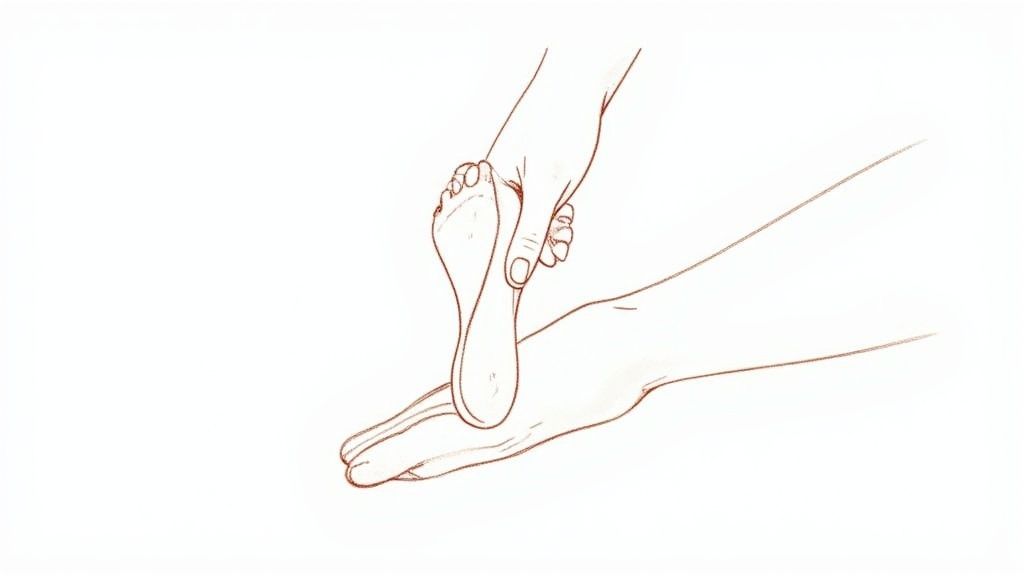
Starting with new insoles for overpronation is a process. It’s a lot like breaking in a new pair of high-quality leather boots or even starting a new exercise program. You wouldn’t run a marathon on day one, right? The same logic applies here.
Your feet and leg muscles have gotten used to moving in a certain way for a long time. When you introduce a supportive insole, you’re essentially asking those muscles to learn a new, healthier pattern. That’s why you might feel a little different or even slightly achy at first. This is completely normal—it’s a sign that your body is beginning to adjust to a better alignment.
That initial feeling of firm support right under your arch can feel a bit strange, especially if your arches have been collapsing for years. Don't mistake this for a bad fit. It's actually a sign the insoles are doing their job, guiding your foot back to where it should be. The trick is to ease into it, not force it.
Your Gradual Acclimation Plan
One of the biggest mistakes people make is trying to wear new insoles all day right out of the box. This can overwhelm your feet and lead to unnecessary discomfort. A slow, steady approach is always the best way to let your body adapt comfortably.
A typical break-in period lasts about 7 to 14 days. Here’s a simple schedule to follow that makes the transition a breeze:
- Days 1-2: Wear the new insoles for just one hour a day. After that, pop them out. This gives your feet a gentle introduction to the new support.
- Days 3-4: Up the time to two or three hours a day. You'll likely start to feel more aware of your arch, which is exactly what we want.
- Days 5-7: Now you can increase wear time to four or five hours. At this point, your foot muscles are really starting to get the hang of their new, corrected position.
- Week 2 and Beyond: Keep adding about an hour of wear time each day. If you feel any real discomfort, just dial it back to the previous day's duration for a day or two before trying to increase it again. Before you know it, you’ll be wearing them all day without even thinking about it.
Normal Sensations vs. Warning Signs
It's so important to know the difference between the normal "getting used to it" feeling and a genuine red flag that something isn't right.
What’s normal? Feeling a firm pressure under your arch, almost like a small, supportive tennis ball is there. You might also notice muscles in your feet, calves, and even your thighs feeling like they’ve had a light workout. This is your body recalibrating its mechanics.
Think of that initial pressure under your arch as a "good" ache, like when you stretch a muscle that's been tight for a long time. It’s the feeling of your body getting back into proper alignment.
What’s not normal? Sharp, stabbing, or pinching pain. These are warning signs. This kind of pain could mean the insole isn’t the right shape for your foot or isn’t sitting correctly in your shoe. If you feel anything like this, take the insoles out immediately. Pain that doesn’t go away or gets worse is your body telling you to stop and check the fit. Ultimately, listening to your body is the most crucial part of this whole process.
Why Samurai Insoles Are the Right Choice for You
Knowing what makes a good insole is one thing, but finding one that actually works for your life—combining real support with genuine comfort—is a whole different ballgame. This is exactly where Samurai Insoles shine. They were developed by a podiatrist who was tired of seeing patients struggle with the same old problems: overpronation and the relentless foot fatigue that comes with it.
The idea behind them was simple but powerful: getting support shouldn't feel like you're walking on a pair of bricks. So many rigid orthotics push your foot into a position that feels unnatural, trading one kind of pain for another. Samurai Insoles work with your foot's natural stride, gently guiding it back into alignment instead of forcing it.
The Springy Support You Can Actually Feel
At the heart of every pair of Samurai Insoles is our unique molded orthotic shell. Forget those hard, unforgiving plastic inserts that feel like a plank in your shoe. Our core is engineered to be firm enough to provide structure but springy enough to feel alive.
This dynamic support is the key. As your arch tries to collapse with each step, the insole gently pushes back, providing the lift you need. But it also has just enough give to absorb impact and feel responsive, not restrictive. It’s the perfect balance between flimsy gel pads that offer zero support and overly stiff orthotics that just hurt.
Think of it like the suspension in a car. It's firm enough to keep you stable on the turns but flexible enough to soak up the bumps for a smooth ride. That’s exactly what our insoles for overpronation do—give you stability and comfort in one smart package.
The goal isn’t just to stop pronation; it’s to control it. The spring-like action of Samurai Insoles helps retrain your foot’s biomechanics, encouraging a healthier gait pattern while providing immediate relief.
This kind of intelligent design is exactly what people are looking for. The U.S. shoe insoles market was valued at about USD 1.85 billion in 2023 and is expected to hit around USD 3.10 billion by 2033. This isn't just a niche medical product anymore; it's becoming a mainstream tool for everyday wellness. You can read the full market report for more data on this trend.
Designed to Fit Your Shoes and Your Life
Let's be honest—one of the biggest headaches with orthotics is their size. They’re often so bulky that you have to ditch your favorite shoes just to get the support you need. We designed Samurai Insoles to fix that. Their lightweight, low-profile design means they fit without a fight.
You won't have to deal with your toes being crowded or your shoes suddenly feeling two sizes too small.
- Ninjas: Our most versatile model. You just slip them right under your shoe's existing insole for powerful, targeted arch support without changing the shoe's overall feel.
- Originals: A classic, full-length design that completely replaces your factory insole, giving you consistent support from heel to toe.
- Sumos: Need extra cushioning? Sumos are for you. They’re perfect for high-impact activities or long days on your feet, combining our signature support with an extra layer of shock-absorbing foam.
- Shoguns: This is our most advanced model. It features a built-in heel lift and enhanced pronation control for anyone who needs maximum stability.
This versatility means you don’t have to compromise. You can get that crucial alignment and support in your running shoes, work boots, dress shoes, or weekend loafers. To learn more about how these different types work, check out our guide on orthotic insoles for overpronation.
From Smart Features to Real-World Benefits
At the end of the day, it all comes down to results. How does a well-designed insole actually make your day better? Here’s a quick breakdown.
| Feature | Your Benefit |
|---|---|
| Podiatrist-Designed Orthotic Core | You get expert-level alignment that gently guides your foot, easing strain on your plantar fascia, ankles, and knees without feeling harsh or aggressive. |
| Springy, Dynamic Support | Your feet feel energized, not trapped. The insoles absorb shock and return energy, cutting down on the fatigue that comes from being on your feet all day. |
| Lightweight, Low-Profile Design | You can finally wear the shoes you actually like without giving up support. Our insoles fit into most footwear, giving you freedom and style. |
| Durable, High-Quality Materials | You can count on them to go the distance. Proudly assembled in the USA, these insoles are built to handle everything from morning walks to tough work shifts. |
By focusing on a design that is both incredibly effective and easy to live with, Samurai Insoles offer a practical, powerful solution. They give you the alignment, pain relief, and all-day comfort you need to get back on your feet and move with confidence.
Common Questions About Insoles and Overpronation
So, you've learned a bit about overpronation and how insoles can be a game-changer. But it's natural to still have some practical questions buzzing around. Think of this as our final chat, where we clear up the common "what ifs" and "how-tos" that pop up when you're ready to get serious about your foot health.
Getting straight answers to these questions is what builds the confidence to finally take control of your feet. We'll cover everything from how long a good pair of insoles should last to whether they can actually fix your feet for good.
How Long Do Insoles For Overpronation Last?
This is one of the first things people want to know, and for good reason! The honest answer is: it depends. Insoles aren't a one-and-done purchase. Just like the tires on your car, they have a lifespan. They take a beating with every step, and over time, they lose their ability to give you the support you're counting on.
A few key things affect how long they'll last:
- What they're made of: Those squishy gel or foam insoles you find at the drugstore might feel nice at first, but they compress and bottom out fast—sometimes in just three to six months. Firmer, structured insoles made with a durable inner shell, like the ones we build for Samurai Insoles, are designed to go the distance.
- How you use them: A marathon runner is putting way more stress on their insoles than someone wearing them for daily walks. High-impact activities simply wear them out faster. It’s just physics.
- Your body weight: It's a simple fact that a heavier person will put more force through their insoles with every step. This can cause the supportive materials to break down more quickly than they would for a lighter individual.
As a general guideline, you should plan on replacing a quality pair of over-the-counter orthotics every six to twelve months. It's a great idea to give them a quick inspection every now and then.
Think of your insoles as a critical piece of equipment. Using them past their prime is like running on bald tires—you're no longer getting the stability and safety you rely on, which puts you at risk for recurring pain and injury.
Look for the tell-tale signs. Are there visible cracks in the hard support shell? Does the arch feel "mushy" or less supportive when you press on it? Is the top fabric worn through? Sometimes, the first clue is that old, familiar ache starting to creep back into your feet or knees. That's your body telling you the insoles have done their job and it's time for a fresh pair.
Can Insoles Permanently Fix Overpronation?
This is a really common hope, but it’s crucial to set the right expectations. For most adults, overpronation is a structural issue. It’s part of your foot's natural anatomy, often linked to things like low arches. Because of this, insoles work as a powerful management tool, not a permanent cure.
Here's an analogy: think of insoles like eyeglasses. Glasses correct your vision perfectly while you're wearing them, letting you see the world in crisp detail. But taking them off doesn’t mean your eyes have been permanently fixed. Insoles do the same thing for your feet. They provide the alignment and support you need while you're wearing them, taking the daily strain off your joints and ligaments.
But that doesn't mean the benefits are fleeting. By wearing supportive insoles consistently, you’re doing so much more:
- Preventing Future Damage: You’re stopping that constant, grinding stress on your ankles, knees, and hips, which can prevent more serious issues down the road.
- Teaching Your Body: Your muscles and nerves start to learn what proper alignment feels like. This can lead to subtle but meaningful improvements in your posture and gait, even when you're barefoot for short periods.
- Giving Tissues Time to Heal: If you're already in pain from something like plantar fasciitis, insoles provide a supportive environment that allows those inflamed tissues to finally rest and recover.
So, while they may not "cure" the root cause, they are an incredibly effective long-term strategy for managing overpronation and living a life free from its painful symptoms.
OTC Insoles vs. Custom Orthotics: Which Is Better?
This is the big debate: off-the-shelf insoles versus pricey custom orthotics. Custom orthotics are made by a podiatrist from a mold of your feet. They offer a highly specific fit, but that comes with a hefty price tag—often $300 to $800—and a notoriously rigid feel that many people find uncomfortable.
The great news is that high-quality over-the-counter (OTC) insoles, like Samurai Insoles, have really closed the performance gap. For most people dealing with overpronation, they are often the smarter choice. Here’s why:
- Accessibility & Cost: They are dramatically more affordable and you can get them right away, no doctor's appointment needed.
- Designs That Work: Reputable OTC brands base their designs on the biomechanics of thousands of feet, creating a shape that effectively addresses the most common alignment issues.
- Comfort & Flexibility: Many people struggle with the rock-hard feel of custom orthotics. A well-designed OTC insole strikes the perfect balance between firm, meaningful support and the flexibility needed for all-day comfort.
The bottom line? For most cases of mild to moderate overpronation, a top-tier OTC insole provides all the correction you need. Custom orthotics are typically best reserved for people with severe foot deformities, very complex biomechanical problems, or those who have already tried high-quality OTC options without success.
Do I Need to Wear Insoles in All My Shoes?
For the best results? Yes, consistency is your best friend. Your feet don't just decide to overpronate in your running shoes. They do it in your work shoes, your casual sneakers, and even your dress shoes. To truly keep pain and strain away, you need to have support in the footwear you spend the most time in.
This doesn't mean you have to buy a dozen pairs of insoles. Most people just move their primary pair from one shoe to another as needed. However, since shoes come in all different shapes and sizes, that isn't always a perfect solution. A great strategy is to have one main pair for your most-worn shoes (like your daily work or walking shoes) and maybe a second, slimmer pair for other footwear.
This is why having versatile options is a huge plus. For example, models like the Samurai Insoles Ninjas are designed to be thin and slip right under your shoe's existing liner. They're perfect for those tighter-fitting shoes where a full-length insole just won't fit, ensuring you get that crucial support no matter what's on your schedule.
Ready to feel the difference that expert-designed support can make? Stop letting foot pain dictate your day. Explore the full range of Samurai Insoles and find the perfect match to restore your body’s natural alignment and help you move with confidence.
